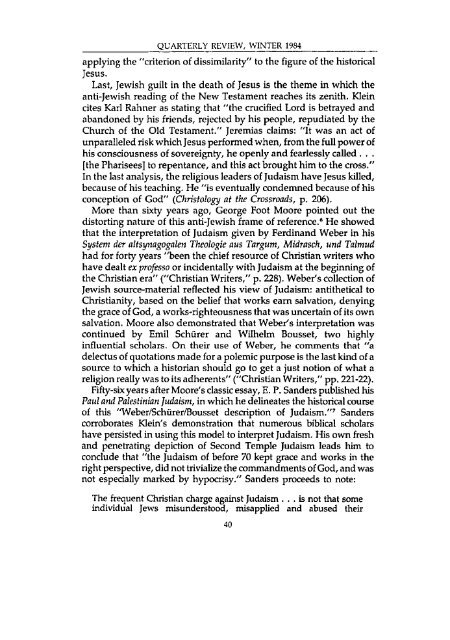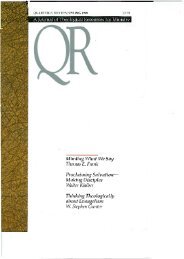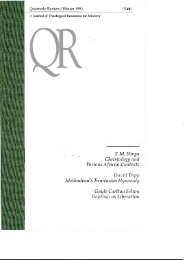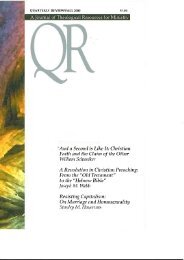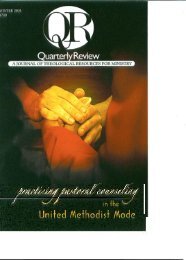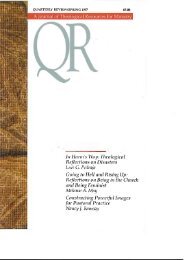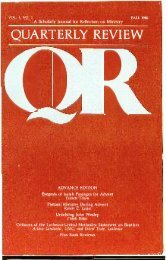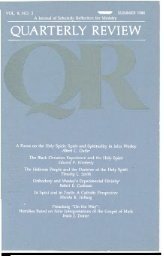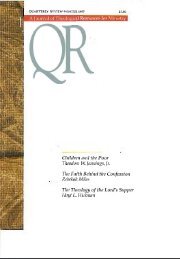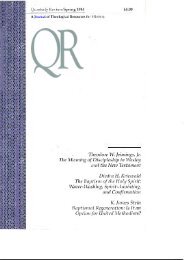Winter 1984 - 1985 - Quarterly Review
Winter 1984 - 1985 - Quarterly Review
Winter 1984 - 1985 - Quarterly Review
Create successful ePaper yourself
Turn your PDF publications into a flip-book with our unique Google optimized e-Paper software.
QUARTERLY REVIEW, WINTER <strong>1984</strong><br />
applying the "criterion of dissimilarity" to the figure of the historical<br />
Jesus.<br />
Last, Jewish guilt in the death of Jesus is the theme in which the<br />
anti-Jewish reading of the New Testament reaches its zenith. Klein<br />
cites Karl Rahner as stating that "the crucified Lord is betrayed and<br />
abandoned by his friends, rejected by his people, repudiated by the<br />
Church of the Old Testament." Jeremias claims: "It was an act of<br />
unparalleled risk which Jesus performed when, from the full power of<br />
his consciousness of sovereignty, he openly and fearlessly called . . .<br />
[the Pharisees] to repentance, and this act brought him to the cross."<br />
In the last analysis, the religious leaders of Judaism have Jesus killed,<br />
because of his teaching. He "is eventually condemned because of his<br />
conception of God" (Christology at the Crossroads, p. 206).<br />
More than sixty years ago, George Foot Moore pointed out the<br />
distorting nature of this anti-Jewish frame of reference. 6<br />
He showed<br />
that the interpretation of Judaism given by Ferdinand Weber in his<br />
System der altsynagogalen Theologie aus Targum, Midrasch, und Talmud<br />
had for forty years "been the chief resource of Christian writers who<br />
have dealt ex professo or incidentally with Judaism at the beginning of<br />
the Christian era" ("Christian Writers," p. 228). Weber's collection of<br />
Jewish source-material reflected his view of Judaism: antithetical to<br />
Christianity, based on the belief that works earn salvation, denying<br />
the grace of God, a works-righteousness that was uncertain of its own<br />
salvation. Moore also demonstrated that Weber's interpretation was<br />
continued by Emil Schurer and Wilhelm Bousset, two highly<br />
influential scholars. On their use of Weber, he comments that "a<br />
delectus of quotations made for a polemic purpose is the last kind of a<br />
source to which a historian should go to get a just notion of what a<br />
religion really was to its adherents" ("Christian Writers," pp. 221-22).<br />
Fifty-six years after Moore's classic essay, E. P. Sanders published his<br />
Paul and Palestinian Judaism, in which he delineates the historical course<br />
of this "Weber/Schurer/Bousset description of Judaism." 7<br />
Sanders<br />
corroborates Klein's demonstration that numerous biblical scholars<br />
have persisted in using this model to interpret Judaism. His own fresh<br />
and penetrating depiction of Second Temple Judaism leads him to<br />
conclude that "the Judaism of before 70 kept grace and works in the<br />
right perspective, did not trivialize the commandments of God, and was<br />
not especially marked by hypocrisy." Sanders proceeds to note:<br />
The frequent Christian charge against Judaism ... is not that some<br />
individual Jews misunderstood, misapplied and abused their<br />
40


